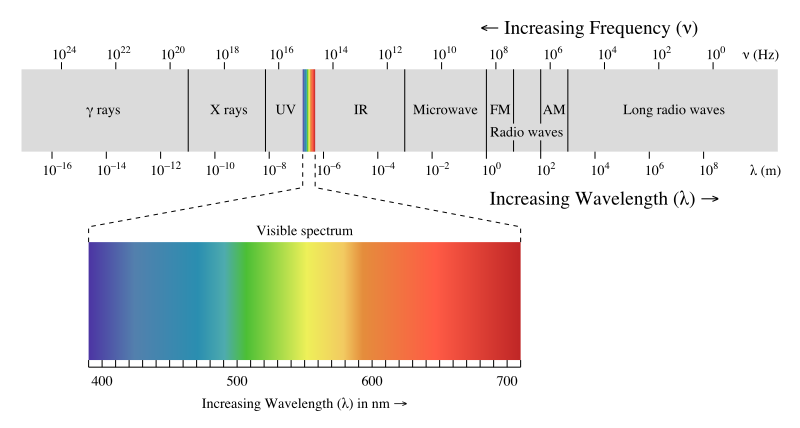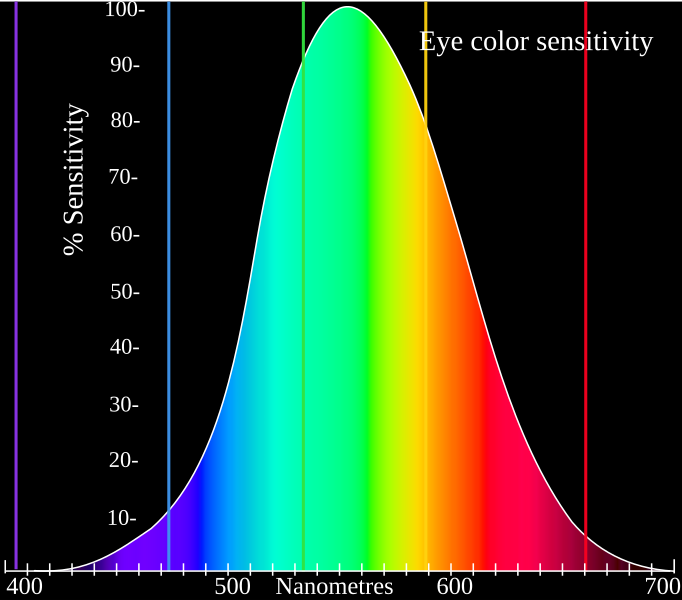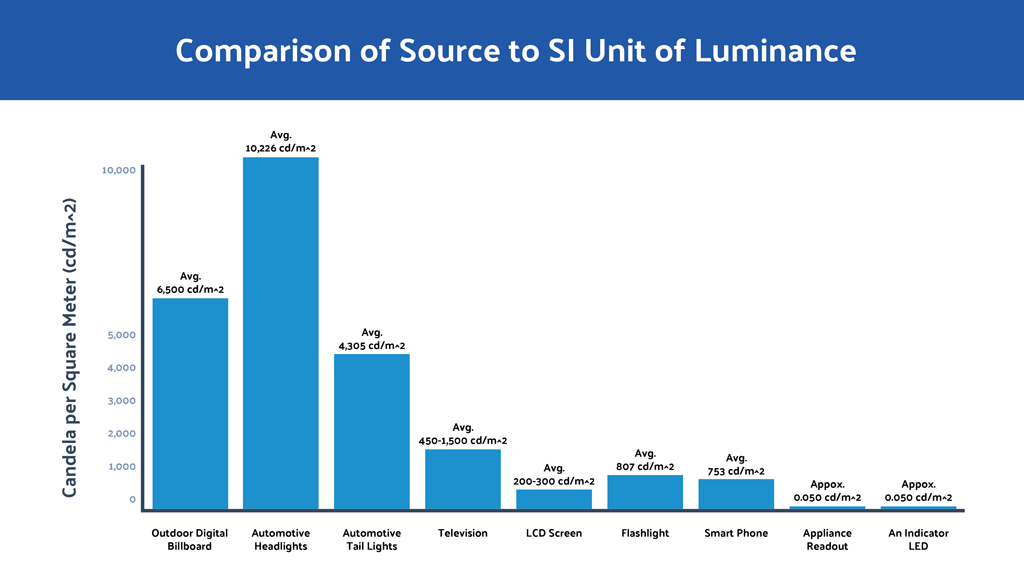
Brightness is an attribute of visual perception in which a source appears to be radiating or reflecting light.
There is often confusion around terms such as luminosity, magnitude, light intensity and how humans actually perceive light. It's important to understand the different terms and technology used in the illumination industry.
As a leading lighting solutions provider, Lumitex is asked frequently, "How bright does my product need to be and how is it determined?"
In order to answer the pending question on light brightness, we need to cover a range of topics leading us to light brightness, including physiology of light and brightness industry standards. Together we will discover color perception, scale of light intensities and answer the renowned question.

What is Light
Light is the visible portion of a larger range of wavelengths known as the electromagnetic spectrum.

Image credit: Electromagnetic spectrum WikiMedia Commons (CC BY-SA 3.0)
This spectrum ranges from Radio waves with building-sized wavelengths, to Gamma rays with subatomic wavelengths. The wavelengths approximately between a virus and a bacterium in size are known as visible light.
The visible spectrum of light is the section of the electromagnetic spectrum that is visible to the human eye, typically 400 nanometers to 700 nanometers.
Where Does Light Come From
Let's first define a few key terms to understand the question asked, "Where does light come from?":
1. Luminance, the original meaning of brightness, is the amount of light per solid angle coming from an area, such as the sky.
2. Apparent Magnitude, in astronomy, apparent magnitude (apparent brightness) equals how bright the star appears from earth. This depends on the location of the observer.
3. Luminosity of a star, is the amount of light it emits from its surface, or the total energy output per second of a star. [source]
The light that we see comes from distant stars; most prominently the Sun of our Solar System.
A radiating body like the sun emits a lot of energy [about 3.84 × 10^26 power], and the energy output per second is called luminosity [L]. As you travel further from a radiant source, the brightness decreases.
Interestingly, this is not a linear drop. If an observer's distance from a source doubles, the luminosity would not drop to 1/2 the original brightness. Due to a principle called the inverse square law, the apparent brightness actually decreases to 1/4 the original brightness.
The variation in a star's brightness is a result of two components:
1. variations in its luminosity
2. variations in its distance
As light travels towards you, it is spreading out and covering a larger area. The concept is illustrated in the image below.

Image credit: Inverse square law, Wikimedia Commons (CC BY-SA 3.0)
S represents an ideal source of electromagnetic radiation. A represents an arbitrary segment of the surface of a sphere of radius r.
This relationship for light is called an inverse-square relationship.
Inverse square law "describes the intensity of light at different distances from a light source. The intensity of light is inversely proportional to the square of the distance." [source]
How Do Humans Perceive Light
As human beings, we see light with our eyes. These special biological sensors have a lot of working parts.
The iris opens and closes in response to light, from about 2 mm at its smallest to 8 mm at its largest. It closes when there is a lot of light to protect the sensitive cells inside of the eye, and opens to allow more light in when there is less available.
Inside of our eyes are millions of tiny sensor cells called cones and rods. Cones perform best between bright moonlight and daylight conditions, while rods help to sense lower light levels.
Cones are color sensors. There are three types of color-sensitive cones, each with pigments that absorb a particular wavelength:
1. 445 nm, which is sensitive to short-wave blue light
2. 535 nm, sensitive to medium-wave green light
3. 575 nm, sensitive to long-wave red light

image credit: Eye Sensitivity, Wikimedia Commons (CC BY-SA 3.0)
The cones collect information and send signals to our brains to interpret the information. Because this is a biological process, there is a wide range of human diversity, and so color and light will be perceived differently by each person.
You may recall the social phenomenon that divided the internet as to whether the dress was white and gold or blue and black. The dress was perceived in different colors. There is a science behind why no one agreed on the color.
An explanation for the difference in color perspective was explained by Bevil Conway, a neuroscientist who studies color and vision at Wellesley College.
Here’s an excerpt of her reasoning...
"What's happening here is your visual system is looking at this thing, and you're trying to discount the chromatic bias of the daylight axis," says Bevil Conway. "So people either discount the blue side, in which case they end up seeing white and gold, or discount the gold side, in which case they end up with blue and black."
In addition, as you can see in the image above, the cone peaks at 555 nanometers. This would indicate that under normal lighting conditions such as daylight, the eye would be the most sensitive to the yellowish-green color. The light at this wavelength produces the highest brightness when compared to light at the other wavelengths.
Understanding Light Brightness and Industry Standards
From the sun to automotive headlights to an LED single color indicator, light sources are all around us. Different types of lights affect the way our eyes view colors. In daylight, we tend to see blue and green most.
In this section, we compare common items such as billboards, headlights and smartphones to their respective "brightness" and its units of measurement.

First, let's give you a baseline from the Sun and Moon in terms of brightness.
Sun (the brightest star)
The sun is the Earth's main source of light. The apparent magnitude is a measure of the star's flux (brightness). The Sun's apparent magnitude is -26.7.
Moon
The moon's surface reflects the light of the Sun. Its apparent magnitude is -12.7 (14 magnitudes fainter than the Sun).
“Brightness” here means, specifically, the amount of sunlight reflecting off the surface of the Moon. Its apparent magnitude is about 400,000 times smaller than the Sun’s, but the Moon’s exact brightness depends on its angle with respect to the Sun and Earth. And those angles follow a complex pattern that repeats roughly every 20 years. [source: How Bright is the Moon, Really?]
To fully understand the concept of how the moon is 14x fainter than the Sun, but only half its actual apparent magnitude, we need to appreciate logarithmic scale.
Logarithmic scale is a "scale of measurement that uses the logarithm of a physical quantity instead of the quantity itself. On a logarithmic scale, each tick mark on the scale is the previous tick mark multiplied by some number." Each position on the scale is marked using the logarithm of a value instead of the actual value.
WinMate, a global leader in developing advanced mobile technologies, compared different lighting conditions and its source. You can view the chart here.
Now let's look at some common objects you are faced with on a daily basis.
Outdoor Digital Billboard
Sign brightness is related to how it interacts and/or contends with the Sun in a day. It would make sense if the brighter the display, the better it can compete with the Sun.
At night, the sign is competing instead with the Moon, and so it appears much brighter even when operating at the same intensity.
"LED’s have high efficiency components. The brightness of these lights, power and colors have come a long way. Power consumption has been significantly reduced and the resolution quality improved.More importantly, most LED units are installed with light sensors that monitor the ambient light. The sensors will automatically adjust the brightness level of the LED unit based on the surrounding light conditions."
With evolving technology, many states in the U.S. are adopting lighting standards. The OAAA (Outdoor Advertising Association of America, Inc.) Code of Industry Principles agrees fully stating, "We are committed to ensuring that the ambient light conditions associated with standard-size digital billboards are monitored by a light-sensing device at all times."
Brightness regulations are an important aspect when implementing electronic signs.
Automotive Headlights
Lumens are the standard measurement of light output in automotive headlights. A car headlight is around 700 lumens with a high-beam headlight at 1200 lumens.
Today there are choices of HID or LED. For headlights, it depends on the application and the desired effect.
According to Power Electronics, LED lighting is gradually penetrating the automotive industry.
"LED technology has allowed lighting to become a distinctive feature and enabled innovative functions like the glare-free adaptive high beam."
The article goes on to say, "Improved LED performance, lower power consumption, and flexible design were the first enablers. Then, cost reductions helped LED technology spread to all vehicle categories."
Leading players are innovating and developing new technologies, including new LED, LCD or laser light sources.
The image below displays how far the auto industry has grown in terms of lighting technology and functionality.
.png?width=1024&name=lumitex-brightness-of-light-determined%20(1).png)
Automotive Tail Lights
Tail lights are the red lights on the back of your car. The Federal Motor Vehicle Safety Standard 108 (FMVSS 108) governs headlight and tail light intensity ranges. The purpose of the standard is to reduce traffic accidents and deaths, by providing adequate illumination.
Luminance measurements are used for products such as automobile tail lights.
LED lights are a popular choice for them and last longer. Halogen lights are another choice. Xenon lights are the third selection for tail lights that are stronger and brighter with high intensity.
Carid wrote an informative article on LED Tail Lights.
A technical writer and product consultant, Timothy Zahl, goes on to say tail lights equipped with LED lights boost the look of any car.
And "LEDs reach full illumination 0.2 seconds faster than standard incandescent bulbs do." Zahl, Timothy. "LED Tail Lights - Are They Brighter, Better-Looking, or Both?" Carid
Television
When shopping for a television today, you may hear the term Nits as well. More Nits equal more light output.
Think of it as a measurement of how much light your TV screen sends to your eyes within the area you are sitting. On average, typical televisions range from 500 to 1,000 nits.
LCD Screen
The measurement of the amount of light the LCD monitor produces is given in nits or candelas per square meter (cd/m2).
A nit is equal to 1 cd/m2.
"Typical brightness ratings range from 250 to 350 cd/m2 for monitors that perform general-purpose tasks. For displaying movies, a brighter luminance rating such as 500 cd/m2 is desirable." [source] "How Computer Monitors Work"
Typical LCD terms involve contrast ratio, luminance, resolution, pixels and viewing angle.
Flashlight
A flashlights brightness is typically indicated in lumens.
They vary from a classic Mini Maglite that peaks at around 15 lumens, to a typical LED headlamp that puts out 50 to 100 lumens. Larger flashlights can go as high as 4000 lumens.
Smart Phone
Without a quality display, user experience falls short. Color reproduction and brightness is a want for most users.
Smartphones and tablets have extremely powerful lights. The screens glow so brightly that they can be viewed in daylight and nighttime.
Ferris Jabr, contributing writer for Scientific American, reinforced the reasoning for the brightness:
"By combining the new blue LEDs with older green and red ones or coating blue LEDs with chemicals that re-emit other wavelengths, technology manufacturers could generate full-spectrum white LED light for the first time.
Because LEDs are much more energy-efficient than their fluorescent predecessors, they soon became ubiquitous in TVs, computer screens, tablets and certain e-readers, infusing homes and offices with much brighter blue light than ever before."
Similar to computer displays, Nits are used to describe the brightness of smartphones.
Appliance Readout
The digital revolution has even made its way into appliances in the kitchen. For example, some oven displays can control the brightness on its control panel, and some have different contrast options.
One drawback to ovens and ranges with a digital display is that the display can start to dim over time. A few resolutions to this issue could be replacing capacitors on the electronic control board or replacing the entire control board.
The fact remains we are seeing more appliances with better lighting. The Nit is the unit of measurement that is used for light given off in digital displays such as visual appliances.
An Indicator LED
LED light panels give a visual indication of a system status at a glance. Think of your car that has a check engine light that displays. It's a sign there is a malfunction.
Choosing the right LED indicator depends on mounting, correct voltage, current ratings, and color. LEDs are effective and efficient for colored light applications.
How Bright Does my Product Need to be
Depending on which technology is right for you depends on the application, your business goals, and your budget.
To answer the question, "How Bright Does my Product Need to be?"
It depends.
There are too many variables for a blanket statement. If you're looking at LCD versus LED alone, you have to consider the resolution, pixels, viewing distance and ambient light for starters. The main objectives and budget also come to play.
In product design, each application will have its own product product specification. As a solutions provider, Lumitex is well versed in developing product specifications to ensure compliance with industry standards, and satisfaction of final customers.
Conclusion
Understanding your application and technologies available will drive your final decision.
Need light in a unique configuration?
Lumitex is inspired to help with your innovative lighting solutions that adapt to your idea. We have lighting solutions that provide just the right light for any of your projects.





Comments